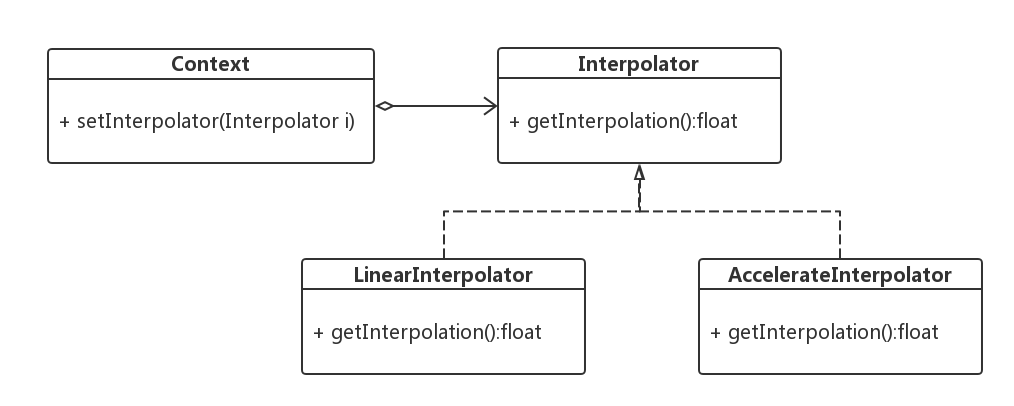行为型模式主要处理类或对象如何交互或如何分配职责。
策略模式
我们写代码的时候,总会处理很多逻辑,由此衍生出很多的if…else,或者case,如果一个条件语句中又包含了多个条件语句,代码就会变得臃肿。而策略模式就是来解决这个问题的。
它的定义是:定义一系列算法,把每一个算法封装起来,并且使它们相互可以替换。
 在策略模式中有以下角色:
在策略模式中有以下角色:
- Context: 上下文角色,用来操作策略的上下文环境,起到承上启下的作用,屏蔽高层模块对策略、算法的直接访问。
- Stragety:抽象策略角色,策略、算法的抽象,通常为接口
- ConcreteStragety:具体的策略实现
模拟一下城市交通系统,假设情况如下:
公交:起步2元,超过5公里每公里加1元。
地铁:5公里内3元,5-10公里4元,最多5元。
出租:每公里2元。
先看下原来的写法
public class PriceCaculator {
public static final int BUS = 1;
public static final int SUBWAY = 2;
public static final int TAXI =3;
private int busPrice(int km){
int busP = 2;
if (km>5)
busP = busP+km-5;
return busP;
}
private int subwayPrice(int km){
int subwayP=0;
if (km<5)
subwayP = 3;
if (km>5&&km<=10)
subwayP=4;
if (km>10)
subwayP=5;
return subwayP;
}
private int taxiPrice(int km) {
return 2 * km;
}
public int getPrice(int km,int type){
if (type==BUS)
return busPrice(km);
if (type == SUBWAY)
return subwayPrice(km);
if (type==TAXI)
return taxiPrice(km);
return 0;
}
}
客户端调用
public class Main {
public static void main(String[] args) {
PriceCaculator priceCaculator = new PriceCaculator();
int price = priceCaculator.getPrice(10,2);
System.out.println(price);
}
}
当我们需要增加一种交通工具的时候,就需要到原来的类去改,违背了开放封闭原则
接下来我们用策略模式修改一下 定义策略接口
public interface CalculateStrategy {
int calculatePrice(int km);
}
策略实现
public class BusCalculate implements CalculateStrategy {
@Override
public int calculatePrice(int km) {
int busP = 2;
if (km>5)
busP = busP+km-5;
return busP;
}
}
public class SubwayCalculate implements CalculateStrategy {
@Override
public int calculatePrice(int km) {
int subwayP=0;
if (km<5)
subwayP = 3;
if (km>5&&km<=10)
subwayP=4;
if (km>10)
subwayP=5;
return subwayP;
}
}
public class TaxiCalculate implements CalculateStrategy {
@Override
public int calculatePrice(int km) {
return 2 * km;
}
}
Context:
public class PriceCalculate2 {
private CalculateStrategy calculateStrategy;
public void setCalculateStrategy(CalculateStrategy calculateStrategy){
this.calculateStrategy=calculateStrategy;
}
public int getPrice(int km){
return calculateStrategy.calculatePrice(km);
}
}
客户端:
public class Client {
public static void main(String[] args) {
PriceCalculate2 priceCalculate2 = new PriceCalculate2();
priceCalculate2.setCalculateStrategy(new SubwayCalculate());
int price = priceCalculate2.getPrice(10);
System.out.println(price);
}
}
在Android中也有策略模式,具体的实例就是属性动画
Animation animation = new AlphaAnimation(1,0);
animation.setInterpolator(new AccelerateDecelerateInterpolator());
imageView.setAnimation(animation);
animation.start();
animation.setInterpolator()其实用的就是策略模式,Android中有很多不同的插值器,都实现了Interpolator接口。 然后通过setInterpolator设置给Animation。
在动画执行的时候,会通过设置的计时器来在不同的动画时间执行不同的动画效果。
public void setInterpolator(Interpolator i) {
mInterpolator = i;
}
protected void ensureInterpolator() {
if (mInterpolator == null) {
//默认就是加速度插值器,在Animation初始化的时候执行。
mInterpolator = new AccelerateDecelerateInterpolator();
}
}
public boolean getTransformation(long currentTime, Transformation outTransformation) {
......
if ((normalizedTime >= 0.0f || mFillBefore) && (normalizedTime <= 1.0f || mFillAfter)) {
......
//通过策略模式来获取不同的值。
final float interpolatedTime = mInterpolator.getInterpolation(normalizedTime);
applyTransformation(interpolatedTime, outTransformation);
}
......
}
